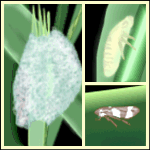Cuckoo-spit and the Froghopper
Created | Updated May 1, 2009

The name cuckoo-spit is said to have derived from the arrival of the spittle on plants which coincided with the first call of the cuckoo in spring. There are also oblique references to superstitions about spitting, whenever a cuckoo is heard, to avoid bad luck. Certainly cuckoo-spit was an important ingredient in witches' brew (as in Macbeth) and in Scandinavian countries the froth is known as 'witches' spit'.
What is Cuckoo Spit?
Cuckoo-spit is the white, frothy substance found on certain plants during the spring and early summer. It is produced by the froghopper, or 'cuckoo-spit insect' which is also sometimes called the 'spittle-bug'. The froth is also known in the United States as 'snake-spit', 'frog-spit' or 'toad-spit'.
What is a Froghopper?
The froghopper is an insect, and a member of the order Homoptera. As such it is related to both cicadas and aphids. The Common Froghopper (Philaenus spumarius) is the most widespread example in the UK, although related species are found worldwide. Typically the adult froghopper is between 4mm and 7mm long. They are called froghoppers because from above they appear frog-like, and they are able to hop significant distances when disturbed.
Habitat
In nature, the habitats froghoppers are most often found in are woodland edges and grassland. However, they are also a pest known particularly to fruit-growers. They feed on plant sap which they extract from the leaves and stems of plants. This causes minor damage in itself, but the insects carry viruses which can cause serious harm to crops. The eggs are laid on a variety of plants including nettles and grasses as well as the tender young shoots of willow, cherry and apple. In gardens they are frequently encountered on such plants as chrysanthemum, dahlia, fuchsia, lavender, rosemary and rose.
Life-cycle
The life-cycle of the Froghopper is in three stages: egg, nymph, and adult. In this respect it is similar to such insects as grasshoppers and dragonflies1.
Up to 100 eggs are laid by the adult females in the late summer into an incision made into the tissues of the host plant. The eggs hatch into nymphs the following spring.
The nymph is the sexually immature stage. It resembles the adult in shape but unlike the adult has no wings and only rudimentary legs and eyes. Crucially, it has but a thin outer body layer, or exoskeleton, which unlike the adult's is not covered by a waxy layer. For this reason it needs to protect itself from desiccation. This is achieved by surrounding itself in a frothy mass of soapy bubbles known colloquially as cuckoo-spit. The froth also helps to protect the developing nymph from predators by disguising the nymph. If determined to seek out the insect, the predator will be dissuaded by the unpalatable taste of the froth. (If you do not believe that, try it sometime for yourself!) Enclosed within this froth, the nymph moults several times before emerging as an adult in early summer.
The adult has a hardened exoskeleton enabling it to survive without need for the protection of the cuckoo-spit. They are normally a mottled red-green or brown in colour, although there is variation in hue. The adult has well developed legs which enable it to 'hop' very large distances to avoid predation. They also have a single pair of wings2. After laying its eggs the adult female dies.
How is Cuckoo-Spit Produced by the Froghopper?
The nymph feeds head downwards with its syringe-like mouthparts embedded in the tissue of the plant. The froth is created by the insect excreting a fluid, the result of excess undigested plant sap, exuding through the anus. This sap, as it is excreted, mixes with a secretion from the abdominal glands. Air bubbles are introduced through a special valve on the abdomen which acts like a bellows, and contact with the air causes the liquid to ferment, forming the froth (or spittle).

